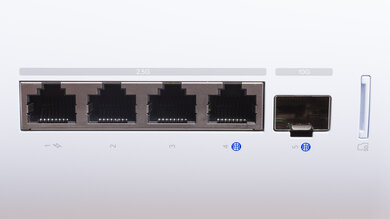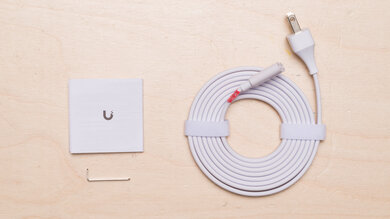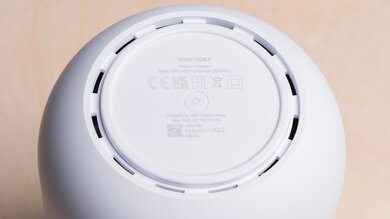The UniFi Dream Router 7 is a tri-band Wi-Fi 7 router and the successor to the Wi-Fi 6 UniFi Dream Router. It's manufactured by Ubiquiti and is part of their UniFi family of Wi-Fi integrated Cloud Gateways. It has a rather compact, pill-like design with a status LED ring on the top and a 0.96-inch information display on the front. It features a laundry list of hardware and software features more commonly found on enterprise equipment than consumer routers. Namely, a 10Gbps SFP+ WAN port, a 2.5Gbps WAN port, and three 2.5Gbps LAN ports. It supports UniFi's Network, Protect, Talk, Access, and Connect applications, which allow you to manage everything from mesh access points to security cameras to EV chargers.
Note: We've removed the Wi-Fi coverage tests as we explore better ways to convey these results to users.
Our Verdict
The UniFi Dream Router 7 is excellent for apartments and smaller homes. It delivers impressive speeds that are suitable for fast downloads and high bandwidth activities for multiple concurrent users. It has a 10Gbps SFP+ WAN port, a 2.5Gbps WAN port, and three 2.5Gbps LAN ports. One of its LAN ports even supports PoE to power compatible external devices like security cameras. Speaking of which, this router supports UniFi's full application suite with advanced functionality like a platform for monitoring and storing security camera footage, support for VoIP phone systems, IoT security systems, and highly configurable and scalable Wi-Fi and network switching.
-
Wi-Fi 7 support.
-
Ample multi-gigabit networking ports.
-
Amazing top speeds.
-
Very good range.
-
Flexible and powerful suite of software tools and hardware compatibility.
The UniFi Dream Router 7 is a great router for multi-level homes. It delivers excellent top speeds and good range, making it suitable for a household of users doing high-bandwidth activities like streaming 4k video and downloading large files quickly. It also has an impressive port selection with a 10Gbps SFP+ WAN port, a 2.5Gbps WAN port, and three 2.5Gbps LAN ports, one of which supports PoE. In addition to its hardware capabilities, it has much more advanced functionality and supports UniFi's full application suite. Using the applications, you can control and manage your network and other UniFi devices, along with VoIP phones, security cameras, and additional access points. Overall, the router's performance and advanced feature set make it a compelling choice for advanced home users or even the centerpiece of an IT system for small businesses.
-
Wi-Fi 7 support.
-
Ample multi-gigabit networking ports.
-
Amazing top speeds.
-
Very good range.
-
Flexible and powerful suite of software tools and hardware compatibility.
The UniFi Dream Router 7 delivers excellent speeds suitable for a multi-gigabit internet connection. It supports Dynamic Frequency Selection (DFS), which provides access to more channels for better speeds in congested wireless environments like apartment buildings.
-
Wi-Fi 7 support.
-
Amazing top speeds.
The UniFi Dream Router 7 has good range. It's also compatible with UniFi's catalog of wireless access points with a variety of ways to expand the range of your network, including adding more units using a wired or wireless backhaul.
-
Wi-Fi 7 support.
-
Very good range.
Changelog
- Updated Jun 10, 2025: We've converted this review to Test Bench 0.8.1. This includes a new test result for our Test Configuration box.
- Updated Jun 10, 2025: Review published.
- Updated Jun 02, 2025: Early access published.
- Updated May 27, 2025: Our testers have started testing this product.
- Updated Apr 23, 2025: The product has arrived in our lab, and our testers will start evaluating it soon.
Differences Between Sizes And Variants
The UniFi Dream Router 7 doesn't have any variants. You can see a picture of our unit's label here.
Compared To Other Routers
The UniFi Dream Router 7 is a tri-band Wi-Fi 7 router and the successor to the Wi-Fi 6 UniFi Dream Router. It's part of UniFi's Wi-Fi integrated 'Cloud Gateway' lineup, and it offers functionality that's well beyond the typical consumer routers. For starters, it has impressive hardware with a 10Gbps SFP+ WAN port, a 2.5Gbps WAN port, and three 2.5Gbps LAN ports (one of which supports PoE), all crammed into a fairly small and sleek enclosure. One of its biggest selling points, however, is its flexibility and integration with UniFi's full suite of applications: Network, Protect, Access, Talk, and Connect. Using these, you can manage and configure your network, security cameras, intercom systems, VoIP phones, and even EV charging stations. This functionality brings the router much closer to an enterprise networking solution, but in a package you can fit in your living room.
As for its performance as a wireless access point, it compares well to consumer routers like the ASUS ZenWiFi ET9 and the TP-Link Archer BE550, boasting excellent top speeds and good range.
See our recommendations for the best long-range Wi-Fi routers, the best Wi-Fi routers, or the best routers for streaming.
The UniFi Dream Router 7 (UDR7) and the UniFi Express 7 (UX7) are tri-band Wi-Fi 7 routers with 2.4GHz, 5GHz, and 6GHz bands. They're both part of UniFi's Wi-Fi Integrated Cloud Gateway lineup and offer a robust feature set and highly configurable software for controlling your home network. The UDR7 supports a wide array of features, like UniFi's full application suite, while the UX7 only supports UniFi's 'Network' application. The UDR7 additionally features three 2.5 GbE LAN ports (one supporting PoE), a 2.5 GbE RJ45 WAN port, and a 10 GbE SFP+ WAN port, while the UX7 only has a 2.5 GbE LAN port and a 10 GbE RJ45 WAN port. Also, the UDR7 has a microSD slot with an included 64GB card for network video storage. The two deliver similar overall performance, but the UDR7's 5GHz band has better range.
The AmpliFi Alien and the UniFi Dream Router 7 are tri-band routers from two of Ubiquiti's product lines. The AmpliFi has a 2.4GHz and two 5GHz bands, while the UniFi has a 2.4GHz, a 5GHz, and a 6GHz band. Performance-wise, the UniFi has better top speeds, while the AmpliFi has better range. Otherwise, the UniFi has a much more robust feature set with highly configurable software and faster wired networking ports, while the AmpliFi is a consumer product with fewer configuration options.
The eero Max 7 and the UniFi Dream Router 7 are tri-band Wi-Fi 7 routers. We tested the eero in a dual mesh configuration, while we tested the UniFi as a standalone unit. The eero delivers significantly faster speeds and better range than the UniFi. That said, the UniFi has significantly more robust software, tools, and features than the eero, like a PoE (power over Ethernet) port, a 10 Gbps SFP+ port, and support for UniFi's full application suite and catalog of networking hardware.
The UniFi Dream Router (UDR) is the predecessor to the UniFi Dream Router 7 (UDR7). The UDR is a dual-band Wi-Fi 6 router, while the UDR7 is a tri-band Wi-Fi 7 router. The latter delivers significantly higher speeds and range, largely thanks to its 6GHz band. Also, the UDR7 has much faster wired networking with a 10Gbps SFP+ WAN port, a 2.5Gbps RJ45 WAN port, and three 2.5Gbps LAN ports. The UDR, on the other hand, only has 1Gbps Ethernet ports. That said, two of the UDR's Ethernet ports support PoE (power over Ethernet), while only one of the UDR7's does.
Test Results
Wi-Fi 7 has faster speeds, lower latency, and supports more simultaneous connections than previous generations of Wi-Fi. However, you'll need devices supporting Wi-Fi 7 to benefit from these features.





